2017 Google Search Quality Rating Guidelines Released- with a new emphasis on Mobile and Usefulness and Fighting Fake News
By Vania Benavides

In May 2017, Google released another update its latest 160 page Full Search Quality Raters Guide, coming only a couple of months after the last release, which saw major changes made to target fake news, science denail and clickbait, among other things.
Each year Google update’s their internal guidelines document that tells its hired human quality raters to evaluate the quality of search results and provide feedback to the search algorithm experiments that it conducts throughout the year. In previous years, Google only released tidbits or summaries of their Search Quality Raters Guide to read. With this document, Google does not reveal any actual ranking secrets or formulas, but it does offer a coveted view as to what the Search Engine considers a priority. As Google’s announcement states, “the guidelines reflect what Google thinks search users want” and therefore can help webmasters and business owners “understand what Google looks for in web pages.” Again to reiterate, the guideline is not the secret algorithm, but it does show what Google is working on and what people should be paying attention to.
Vab Media’s take away from a search engine optimization perspective is that Google has shifted their focus and from “contextual relevance,” to making things “useful.” In other words, whereas in the past making your site’s landing page the most relevant result for a person’s search query, now this content must also fulfill a need or desire for the search to be considered a success. As Andrew Broadbent, our director of Search Marketing noticed, “it’s all about usefulness today and in the future. The goal of Google’s search engine is very simple, to increase the searcher’s satisfaction. That is why being ‘useful’ is going to be a word to watch out for. In the past, we said ‘relevance’ but what we really mean is ‘useful.’”
Companies and business owners should not to try and worry about all the tiny technical details. Leave that to your Digital Marketing Agency. Instead, founders and company decision makers need to extract what Google’s focus is, so they can properly allot budgets and designate priorities in online marketing strategy that will be aligned with what Google’s search algorithm rewards.
Start to Align Your Website with Google’s Priorities
Since Google’s search engine priorities change each year, your company’s SEO strategy should also make the necessary adjustments. Jennifer Slegg was the first one in the SEO world to report about this new 2015 Search Quality Raters Guide being leaked. The biggest changes in Google’s focus are:
- Needs Being Met Focus: There is a new rating scale and ranking factor that has been added that judges how well a website page meets the needs of someone searching on their smartphone. This totally new section for evaluating needs just proves that Google is dedicated to satisfying its users’ needs. And any site that is not designed in a mobile friendly way automatically fails this criterion.
- Mobile Search is Everything: In addition to adding a whole new section that focuses on Mobile search quality, now most of the examples in this guide are screenshots taken from a smart phone.
We have put together a checklist for helping align your SEO campaign with Google’s new priorities and guidelines.
1) Mobile is Now a Front and Center Focus
Is your company’s website really designed in a mobile-friendly way?
To succeed in the digital economy of 2016, it’s no longer good enough to just get a passing grade on Google’s Mobile-Friendly Testing tool for your web pages or apps. Consumers now expect a seamless and comprehensive site experience across all devices. If your website is an eCommerce site, it is now more important than ever that conversion-focused tasks, such as making a purchase, booking a reservation, or researching plans/prices are simple and easy to perform on a mobile device.
The following list will help marketers to evaluate how well your website performs with someone viewing it on a tablet or smartphone device:
- How easy or hard is it to fill out forms or enter data?
- How is the content viewing experience on your site or app on a small screen? And are all the features usable on a mobile device?
- Are the font and content easy to read without having to touch or expand the screen or doing left to right scrolling?
- How is the navigation on a mobile device? Are the links, menus and buttons, large enough to easily move throughout the site?
- What happens on your website when the Wifi connection is slow or inconsistent?
The common theme to keep in mind is that mobile users tend to be very goal-oriented – they expect to be able to get what they need from a mobile site easily, immediately, and on their own terms. Ensure success by designing your site with the mobile searchers context and needs in mind without sacrificing richness of content.
2) Are the Needs Met or Not?
Does your website anticipate and fulfill a mobile web searcher’s needs?
As we mentioned earlier, there is a completely new section in this year’s guide, which is called “Needs Met Rating Guideline.” Here is a quote from section 13.0, which is clearly focused on Mobile users’ needs:
“Needs Met rating tasks, ask you to focus on mobile user needs and think about how helpful and satisfying the result is for the mobile users.”
In order for your website to get a high quality in this new ‘Needs Met’ category, a search engine results page and its landing page should:
- Require very little effort for the user to get instantaneous use or get what they’re searching for.
- Have enough information to satisfy most users that searching for the same thing or answer, (so that they would not need additional web page results)
- Be considered authoritative, trustworthy and offers enough and/or complete information so that it is considered useful to the searcher.
Mobile users have different search intent than desktop or even tablet users. It’s not enough to think about the device, but you also need to think about who is using it. An example would be people shopping at Vineyard Vines or Brooks Brothers are not the same as people shopping at Target or Walmart. Aaron Levy did a comprehensive SMX presentation on mobile audiences.
This seems to be reinforced in the new mobile section of Google’s Search Quality Raters Guidelines, where dozens of web page search result examples all show what a mobile user would probably want when they search for various typed or spoken search queries. At a certain point, the “raters” are told to “think about mobile users when deciding if queries are [a particular type]. Use your judgment here.” The key takeaway for app/website owners and mobile search marketers is this: Try to think about what mobile users may be trying to do, and make sure that your website fulfills these things as directly as possible. Google is all about satisfying mobile users’ needs; you should be as well.
We are not saying that answering all these questions is not going to take some time, but it will pay off in the end to invest time and resources into this.
3) Purpose-Driven Website and Web Pages
Is it easy to figure the purpose of this web page, and does it achieve it?
One of the first things that a rater must do is to determine what a particular page is meant for, and then to decide using Google’s rating criteria of how well this page achieves this purpose. As an example, the purpose of a shopping web page is to sell or give information about a product, the purpose of a news website is to display news. Google has very different standards for different types of web pages, so that is why it is crucial to understand a page’s purpose, so that Google can lay a foundation for accessing quality.
How helpful to a user is the page’s purpose?
Google’s main purpose is that it wants each page to be helpful or at least geared towards helping users. This helpfulness is a large determining factor in the quality ratings. As an example, at the low end of the quality scale, would this particular page harm or deceive users (even though the page may be fulfilling the designed purpose)? If you want Google to deem a page high quality, a page must have a helpful purpose such as:
- To share information about a topic
- To share personal or social information
- To share pictures, videos, or other forms of media
- To entertain
- To express an opinion or point of view
- To sell products or services
- To allow users to share files or download software
- … Many others.
Is the purpose of the website as whole clear?
You want to make sure that your website’s overall purpose is explained clearly and ideally this would be on an about page. However, this ratings guide also includes examples of web pages that have “non-obvious purposes”, this can include pages that the raters thought were pointless or inaccurate with just reading that page, until the rater referred to the FAQ or About page and then discovered they were actually beneficial and useful (see Section 2.2). Also, Google can further investigate and look at independent sources to see or verify if a website’s reputation actually matches what it claims. If they find a conflict, Google typically will side and believe what the outside sources are saying. So for context for you as a small business owner or corporation, a lack of reviews or reputation info does not necessarily mean that the website is considered low quality (see Section 2.7).
4) Meaty Main Content and Helpful Secondary Content
Does this page have high quality main content?
So a web page’s main content (which will exclude sidebars, ads, and other supplementary parts that do not directly fulfill the page’s purpose) can earn a high quality rating from Google if ALL of these are true:
- The website has a good reputation for this page’s topic or subject.
- There is a thorough amount of high quality main content on the page.
- The web page and site have a high level of E-A-T which stands for expertness, authoritative and trustworthiness.
They do not give exact rules for this, and there is no exact minimum amount of words that have to be on a page. Again, these guidelines are just encouraging the raters to use their judgment and to decide whether the page’s main content fulfills the purpose of the page in a satisfactory way.
Is there any supplementary content on the page that is helpful to users?
Google also can recognize that supplemental content “can be a large part of what makes a High quality page very satisfying for its purpose.” So consider what your website can include offering related information, ways for users to find other resources or specialized content that may be helpful to people who are visiting this page.
5) The YMYL Pages Have Higher Standards
So how high quality is your website’s YMYL pages?
Web pages that can have an impact on a person’s “health, future happiness or wealth” are known to Google as Your Money or Your Life (YMYL) pages. So Google first mentioned this concept back in the 2014 Search Quality Rating Guidelines handbook, which basically held these types of pages to a much higher standard across all the quality criteria. Some examples of these would include financial information, e-Commerce shopping transactions, legal or tax information and medical advice sites. The biggest changes are to news sites with Your Money Your Life, as well as further clarifications as to when a page or site should get the Upsetting-Offensive flag, which was introduced with the last update to specifically target fake news as well as other sites publishing fake information.
Maintaining Your Site
Does your site look well-maintained and updated frequently?
Google’s raters are instructed to “browse or poke around” to see whether a website is being maintained. Here are a few examples of what Google would expect of a frequently updated, quality website:
- No broken links
- Images should load
- Pages should continue to function well for users as they visit from different types of web browsers
How fresh or new is your website’s content?
So Google’s algorithm is known use as a ranking factor and to look at “freshness” of the content of many search query phrases. So when the Googlebot crawls your website, will it find any updated or recently added content? Here is a tip, if your website has a blog or pages that are outdated, do not try to manipulate the system by setting up any programs that would automatically change the dates of when a page was posted to try to make things look more recent. Google already knows this scheme. And furthermore, the “raters” are even instructed to manually check a page’s content to see if it is copied or original (see Section 7.4.7) using the tool called the Wayback Machine in order to investigate any suspicious dates. There is no fooling its algorithm, which it does not need to check the this tool to see if the content is original or not, so don’t try to cheat.
A useful and healthy website will frequently update and add new content to keep things fresh, relevant and useful for its visitors.
Is your content expertly written?
Thomas the Tank Engine had the right idea all along.
(Photo credit: Tommy Stubbs/Random House)
So we SEO’s know from the 2014 Search Quality Guidelines that the raters are looking for signs of E-A-T, which again stands for expertness, authoritativeness,and trustworthiness. The 2015 guidelines reinforce this concept, but they are now starting to define “expertise” differently depending on the subject of a page (see Section 4.3) such as:
- There are “expert” websites of all types, even fashion, humor, celebrity gossip, forums, etc.
- Topics on hobbies, such as drawing, photography, and learning to play a musical instrument, also require experts.
- Topics like home remodeling, medical, legal, financial, or tax advice or parenting “should be written by or come from expert sources.”
- Regular people may have “everyday expertise” on topics that they are very familiar with or have life experiences about, such as people who write detailed and thoughtful reviews, tips posted on forums, or answer questions on sites like Yahoo answers or Quora.
Takeaway for business owners, is make sure your website has trustworthy expert content that is “maintained and updated” often to increase your site’s E-A-T rating.
6)About Advertising Guidelines
If your website has ads or has monetized links, are they appropriate for the page’s purpose?
This year’s guidelines state that “the presence or absence of Ads is not by itself a reason for a High or Low quality rating.” Obviously, Google understands that many apps and websites cannot stay in business without the ad revenue. However, Google “will consider a website responsible for the overall quality of the Ads displayed” (according to Section 2.4.3). So pay attention to the amount of and use of display, banner, affiliate or any other types of advertising. Make sure that your website’s ads do not overly distract or overwhelm the page’s useful main content (and any supplementary content either) that the user came to read. They also want there to be a clear separation between advertising and the content.
Overall Conclusion and Takeaways
First and foremost the biggest takeaway from this guide is to make sure your website is mobile friendly. Without it being “mobile friendly,” you are already missing out on a mobile ranking boost and could be pushed further down in the search results when someone does a search on their phone. Adding useful supplementary content, such as related articles, is a simple way to provide additional value to the user and it can keep them on the site longer. Try to find a healthy balance between ad monetization and the user experience. Make sure your website has enough information so that a visitor or quality rater can easily answer simple questions. Such as is this author reputable, or an expert on this subject?
Bottom line; make sure your website presents the user with the highest quality content from credible sources. The higher the perceived value is of your website, the higher the quality rating will be. Now, although this does not automatically translate into higher search rankings, following these guidelines can translate into the type of content that Google wants to give users and show higher in the search results. Make your sites or apps more useful. Take a look at this Search Quality Rating Guidelines infographic.
(Photo credit: Forbes)
What did you learn from this year’s release of Search Quality Raters Guidelines? Let us know in the comments.

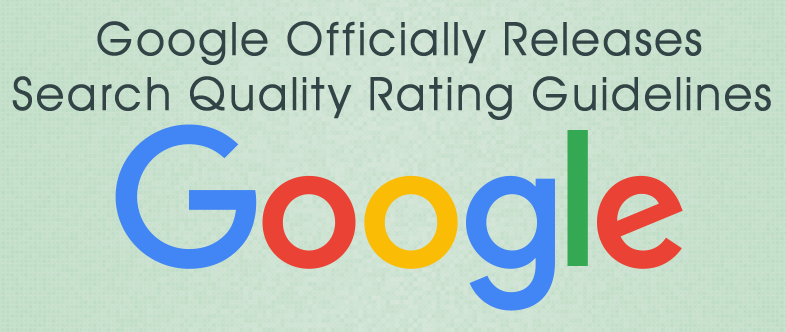
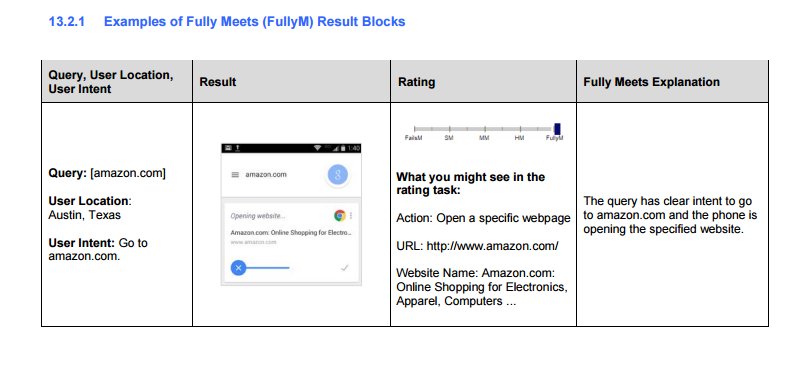
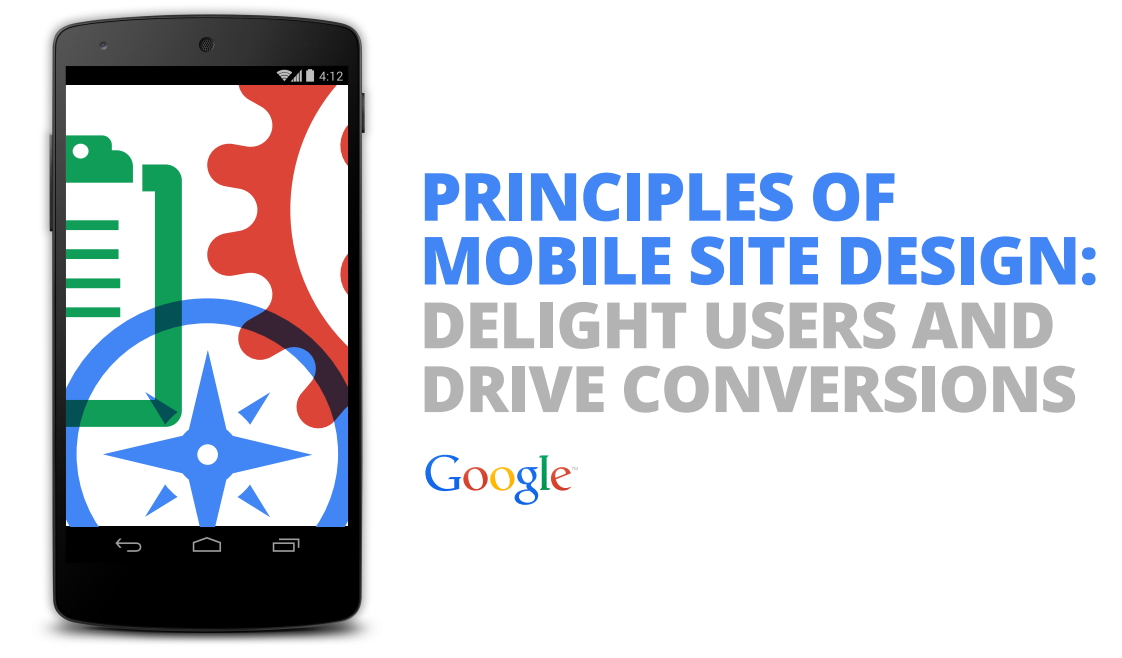
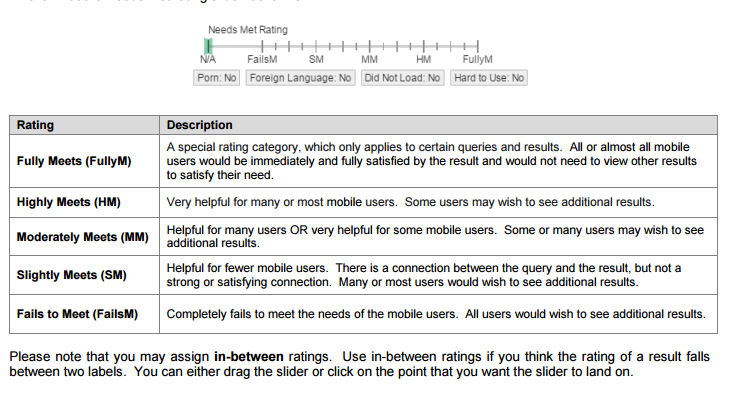
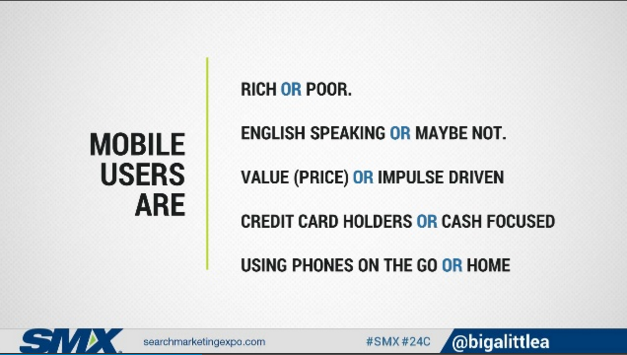

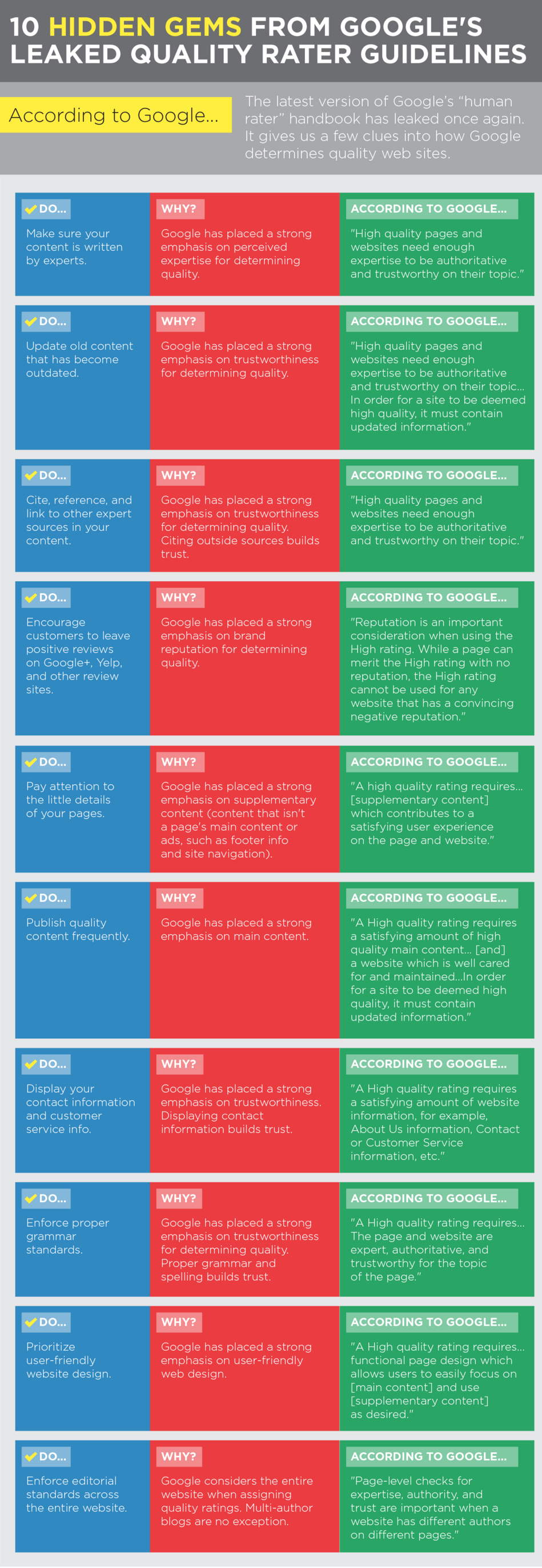



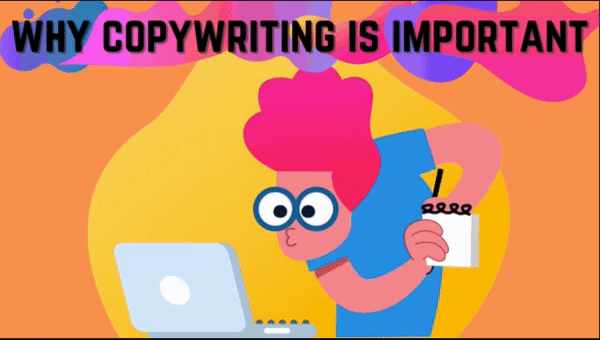
One Response
With Google pushing so much into mobile, I’m sensing that they believe mobile is where commerce is done, desktop is where office productivity is done – thus focusing on mobile is good for Adwords revenue. You’ve served up good food for thought. Thanks!